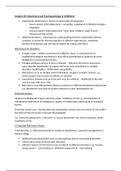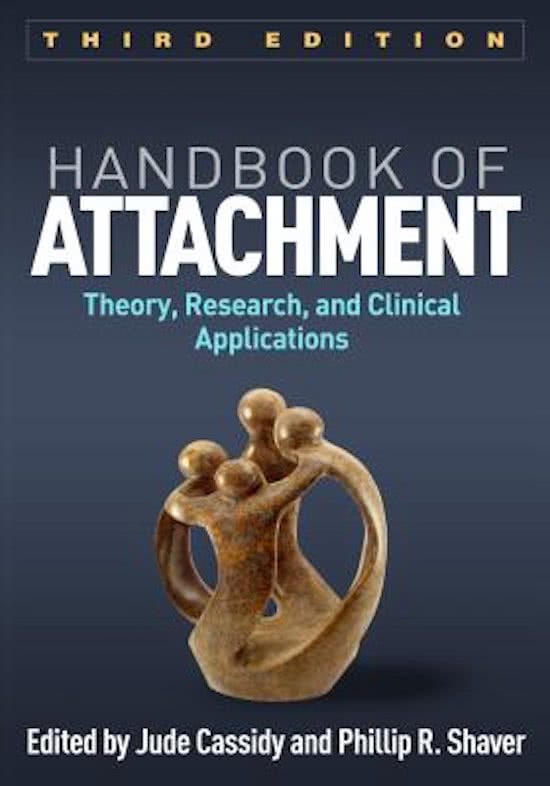Chapter 28: Attachment and Psychopathology in Childhood
Attachment relationship is central to personality development
o Secure parent-child attachment = sociability, compliance & effective emotion
regulation
o insecure parent-child attachment = poor peer relations, anger & poor
behavioural self-control
Attachment theory – important for understanding how the relationship with the
caregiver is central for forming cognitive & affective expectancies, regulating
emotion & behaviour and forming strategies for coping with stress
Risk factors for disorders:
1. A single cause – neither necessary nor sufficient cause. If a disorder has an
established biological mechanism it may still be potentiated or buffered by other
biological or environmental factors.
2. Multiple pathways exist to & form a disorder – different risk factors may lead to
same disorder (equifinality) & a given risk factor may contributed to multiple
disorders (multifinality) – Differential susceptibility
3. Risk factors occur at multiple levels (individual, caregiver, broader context) e.g.
social support may increase sensitivity of caregiver
4. Associations between risk and outcome may be nonlinear – likelihood of disorder
may increase with more risks
5. Risk factors may differentially influence outcomes in different developmental periods
e.g. attachment may have its greater influence in early development etc.
Protective factors:
Reduce the likelihood of poor outcomes under conditions of risk e.g. characteristics of
individual (temperament & intelligence), quality of relationship (attachment) & ecological
factors.
Protective factors can – directly decrease dysfunction, prevent the occurrence of risk, buffer
the effect of the risk factor or disrupt the mediation
e.g. insecurity attachment = risk factor vs. secure attachment can confer protection under
conditions of risk
A Proposed Risk Factor Model
4 risk domains: a. child characteristics b. quality of attachment c. parental management d.
family ecology
Ineffective parenting linked more to externalizing than to internalizing disorders
child trauma relate to dissociative disorders
Different aspects of risk factors may contribute to different disorders e.g. reactive
temperament – externalizing vs. inhibited temperament – internalizing
, Person-oriented analysis: increase in the number of risks increases the likelihood of
disorder: children in clinical setting 34 times more likely than comparison to be at
risk in all four domains.
o risk in only 1 domain insufficient to predict disorder, risk in all 4 domains
increases the chances for the disorder
Process Models & the Contribution of Attachment to Disorder
4 interrelated mechanisms that may link attachment to psychopathology:
1. Observed behaviour e.g. attachment can contribute to maladaptation through direct
effects on behaviour.
attention-seeking behaviour (whining, noncompliance, negative behaviour) may
be effective in short-term and increase caregiver’s attention serve as a setting
condition for later maladaptive interactions
Angry or dependent-behaviours seen in ambivalent children to maintain their
caregiver’s attention become problematic later on
Disorganized – in the absence of a coherent and predictable environment – D
infant takes control of aspects of the relationship e.g. role reversal which can
lead to maladaptive later behaviour e.g. become bossy, parentificaiton
2. emotion regulation e.g. emotion regulation & self-regulation strategies develop &
evolve through the parent-child relationship and shape later responses to challenging
situations
secure children – secure experiences increase their capacity to tolerate &
manage emotions vs. experiences of avoidant & ambivalent (minimization &
exaggeration of emotion) interfere with this process
3. Cognitive-affective structures e.g. forming social cognition, parenting forms the
cognitive-affective schema ‘working model’ of self & others which then biases how the
children will perceive and interpret the actions & desires of others – reinforce
interactions that will stabilize these biases
attachment patterns related to social information processing
secure attachment = positive WM = attributions of responsiveness, warmth,
trust, cooperative interactions
insecure attachment = negative WM, anger, mistrust, anxiety/fear
o may suppress painful info or process it according to negative schemas
o WM influence memory, ToM, attributional biases, emotion
understanding & coping strategies
o hostile attribution bias in insecure = hypervigilance & anger
4. motivational processes e.g. attachment may promote either a generalized positive or
resistant social orientation providing differential levels of readiness of socialization
secure children, have warm contingent relations = more likely to comply with
parent control & develop a prosocial orientation in early and middle childhood
=> facilitate a positive bond with other adults
, Theory & Research Linking Attachment to Childhood Psychopathology
1. AVOIDANT – children discover that by expressing anger in response to their
caregiver’s unresponsiveness or intrusive behaviour will reduce their caregiver’s
proximity in times of stress. Therefore, they learn to diverge their stress in the
environment as the object of anger is not available, perhaps resulting in hostile &
aggressive behaviour
Unresponsive, rejecting caregiver responding to an avoidant infant in an
authoritarian, hostile manner may result in aggressive child behaviour
The underlying anger may be manifested in lying, bullying, blaming and insensitivity
to others
2. AMBIVALENT/RESISTANT – inconsistent or overprotective caregiving may lead to
vigilance & chronic anxiety in response to the fear that their needs will not be met
(inconsistent parenting)
Ambivalent children more likely to develop internalizing problems
Ambivalent children may be easily overstimulated & exhibit impulsivity, restlessness,
short attention spans & low frustration tolerance
3. DIZORGANIZED – parent psychopathology, child abuse, traumatized mother is
unpredictably frightening – ‘unresolved paradox’ mother is both the safe haven &
the source of fear - child unable to regulate own arousal or enlist assistance of
caregiver => they may mentally isolate & fail to process disturbing stimuli leading to
dissociation
Research Comparing Secure vs. Insecure Attachment
Insecure attachment in infancy may set a trajectory that increases the risk for either
internalizing or externalizing psychopathology – attachment serves as a general not a
specific risk factor => evidence of MULTIFINALITY
The Role of Specific Attachment Classifications in Disordered Behaviour
Externalizing Problems
Theory:
Avoidant children might act out to maintain distance from caregiver & lack concern of
others
Ambivalent children may act out to attract attention or express anger or resentment
Secure children – lead to greater awareness of other’s mental states = mentalising ,
insecure children less able so deviant peer relations & are at increased risk for
substance use & criminality
Disorganized – lack of coherent strategy in coping with situations predisposes them to
antisocial behaviour but also vulnerable to internalising problems





